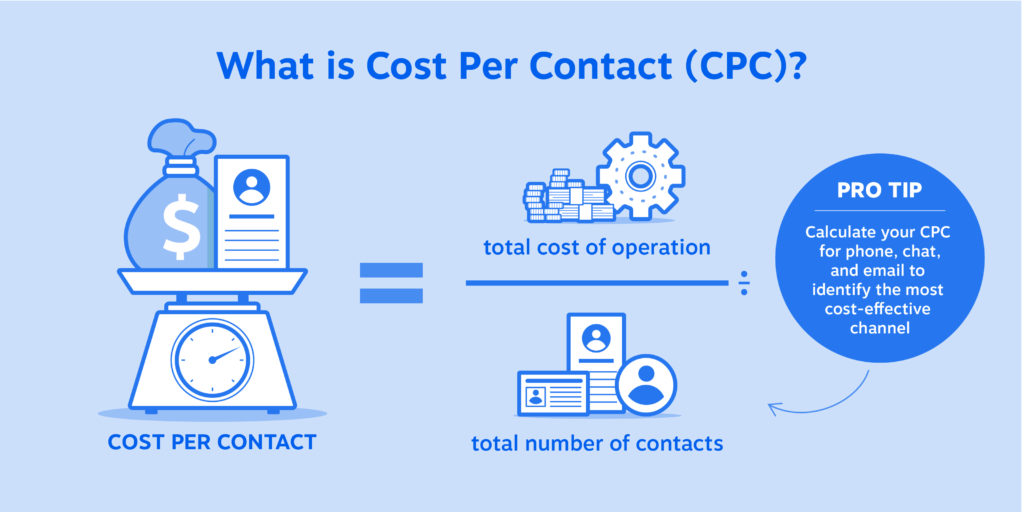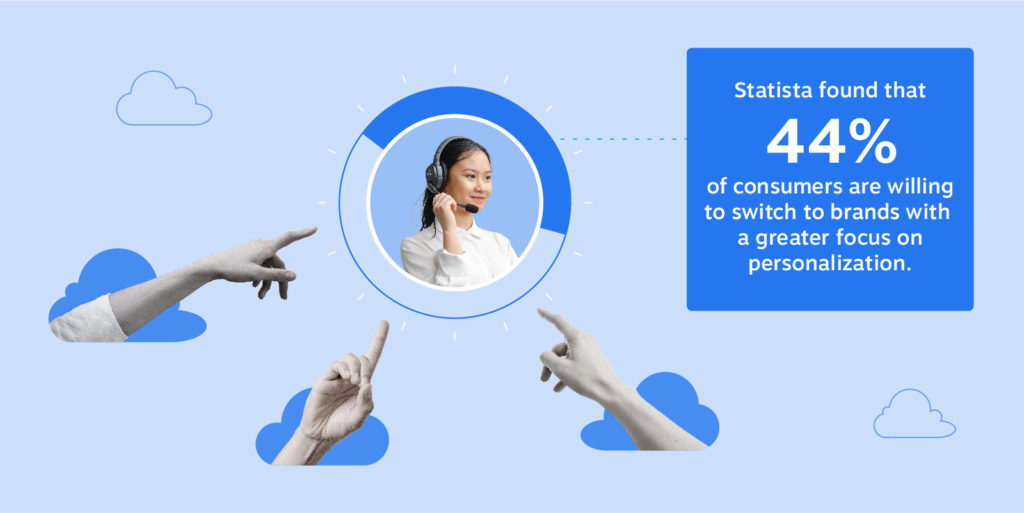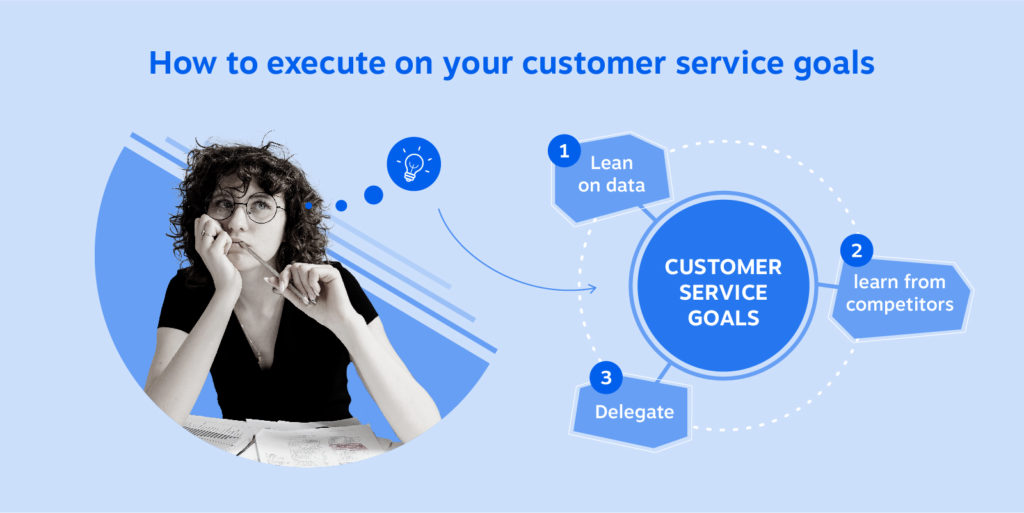Table of Contents

As a call center manager or business owner, one thing is certain — customers are always hungry for better.
In fact, 55% of customers expect the quality of customer service to rise year over year.
This expectation weighs heavily on company leadership. If you’re wondering how to keep customers satisfied as their standards skyrocket, setting effective customer service goals is a great place to start.
You’ve likely heard how important it is to set goals for customer service, but our guide goes a step further. Not only do we back up the importance of these goals using real-world scenarios, but we also guide and empower you to create your own.
Read on for inspiration and guidance as you craft ambitious customer service goals for 2022.
Why you need to set customer service goals
Imagine every customer service representative at your organization perceiving your company’s tone differently. You’d have a lot of inconsistency, brand dissonance, and customer confusion on your hands.
Good customer service goals prevent issues like this from happening. Here’s how:
- They provide direction and stability. When goals are comprehensive and clear, they cut out the guesswork. Your employees will become confident in their workflow.
- They simplify team/employee management. Measurable goals with specific standards and benchmarks make it easier for managers to provide objective feedback and offer clear paths to improvement.
- They help teams align and collaborate. Every division and role in your organization can collaborate to reach milestones. Goals clarify the mutual aim of seemingly disjointed work.
- They increase customer satisfaction. Specific customer service goals should provide an excellent customer experience, setting you apart from the competition.
How to set and measure customer service goals
You can probably think of a few overarching goals for your customer service strategy right off the top of your head. Ideas are great starting points, but goals require structure to have real impact. That’s where SMART goals come in.
Your goals should be:
- Specific. Avoid general statements by specifying the benchmark you want to achieve. Rather than saying, “We will speed up response time,” say, “We will respond within [X hours] [Y% of the time] by [month/quarter/year].” Otherwise, individuals will each develop their own understanding of the goal.
- Measurable. Rely on quantifiable customer service metrics such as customer service score (CSAT score), customer churn rate, and quantity of loyal customers. This will help you track toward your KPIs. Each goal should also only focus on one area, as measuring multiple areas for the same goal can cause confusion.
- Achievable. While ambitious goals can help communicate a vision and push employees to grow, being unrealistic can harm morale. If you ask your employees to improve their performance by 75-100%, they’ll feel like they’ve failed before they even begin. Aim for something more attainable.
- Relevant. Your goals should align with your organization’s mission. If the end goal doesn’t relate to improving customer experience, it isn’t worth including.
- Time-bound. Setting deadlines and checkpoints for your goals provides a sense of urgency. This motivates teams to make progress. Lack of clarity here can cause procrastination or stress out your team.
13 customer service goals to help you stay on top of your strategy
Clear, focused customer service objectives are a necessary part of any customer retention strategy. If a customer feels satisfied and cared for after an interaction with your customer service department, they’ll be far more likely to return.
Let’s explore 13 examples of customer service goals to consider setting for your own organization in 2022.
- Amaze with first response time (FRT)
- Accommodate many contact formats
- Implement an omnichannel strategy
- Survey customers consistently
- Reduce cost per contact (CPC)
- Improve customer onboarding processes
- Develop a customer appreciation strategy
- Make all customer support mobile-friendly
- Automate to fill in human gaps
- Utilize social media creatively
- Innovate with the industry
- Help agents grow
- Empower customers through self-service tools
1. Amaze with first response time (FRT)
In the digital age, people are less patient than ever before. Customers see quick response and resolution time as one of the most important parts of a positive customer experience.
More specifically, nearly a third of customers want an email response from companies within an hour. Keeping wait times this low would satisfy 88% of consumers.
Response time expectations on social media are even more demanding. Most consumers want a response from companies on Facebook within 30 minutes.

If you’re now worrying about your own average first response time, don’t fret. Creating a customer service goal targeting FRT just requires a little strategizing. Here are some tips as you get started:
- Equip yourself with the right tools. Using an integrated business communication platform like Nextiva will help you deliver responses to your customers in a matter of minutes.
- Keep the team properly staffed at all times. Response time is a shared effort for your entire team. Customer service reps need to be supported by a fully staffed team to deliver the best service possible.
- Increase focus with optimized scheduling. Multitasking inhibits focus and productivity. Avoid giving your agents multiple tasks at once so they can focus on one customer at a time. For some inspiration, look to Databox. By assigning a few agents to solely handle chat, the company was able to decrease its chat response time from three hours to 17 minutes in one week.
- Track FRT and regularly set new goals. Improving your FRT starts with tracking it. Set a goal of improving your FRT by a certain percentage each month. Then, adjust that goal depending on team performance.
- Take it one step at a time. If you don’t have the capacity to improve your FRT on every communication platform, choose one to start with. Try first setting improvement goals for Facebook, then adding other platform goals as you go.
In addition to FRT, customers care about average handling time and resolution rate. If you follow the above tips, you should see all of these metrics improve significantly.
2. Accommodate many contact formats
Every customer has their preferred communication channels. These include but are not limited to chat bots, instant messaging, phone calls, and video calls. In fact, customers use an average of nine channels to complete tasks like seeking advice and making purchases.
We found that most companies miss the opportunity to connect with customers via live chat or a chat bot. In fact, companies are more likely to text than chat by a 3:1 ratio.
By accommodating a wide range of channels, you’ll attract customers from every demographic. Consider making channel expansion a key customer service goal this year.
3. Implement an omnichannel strategy
While the term omnichannel can come across as complex, its meaning is quite simple. An omnichannel customer service strategy keeps the customer at the center of everything. It’s about providing a smooth, seamless, and consistent customer experience across every channel.
Gladly sheds light on the importance of this strategy. Its 2020 Customer Expectations report shows that 86% of customers expect communications with agents to “seamlessly move between channels.”
An omnichannel strategy requires team synergy. Every department must communicate clearly and efficiently with one another. It’s one of the most important team goals an organization can set.
Take Goldberg Hedge Funds, for example. Goldberg used Nextiva to integrate its CRM and VoIP phone system. This unified all relevant customer notes, allowing team members to seamlessly join conversations and execute deals. This improved efficiency and increased revenue by 227% within Goldberg’s first six months using Nextiva.
To learn more about how Nextiva helped Goldberg achieve an omnichannel strategy, check out this case study.
4. Survey customers consistently
“Your most unhappy customers are your greatest source of learning.”
— Bill Gates (Oxford Reference)
When crafting a great customer service strategy, feedback is gold. Your customers are using your products firsthand, making them your biggest critics. You can expect honest feedback from them, as they have nothing to lose and everything to gain by suggesting how to make your product better.
That said, customers won’t always provide a description of their experience unprompted. It’s your responsibility to pick their brains by regularly surveying them.
To get started, you’ll need a customer feedback collection tool like Typeform or Loop. Then, decide which customer survey questions would provide you the most insight about customer satisfaction. For example, gauging net promoter score (NPS) through questions like “Would you recommend this product/service to a friend?” accurately measures customer satisfaction.
Ultimately, always be thinking about the customer’s experience when taking the survey. Is the survey being sent to them at the right time? Is there balance between closed- and open-ended questions? Can it be completed relatively quickly?
A survey goal should specify how often you will survey customers. It should also specify how much you want customer experience metrics to improve over time.
5. Reduce cost per contact (CPC)
Cost per contact (CPC) is one of the most effective ways to gauge the health of your call center. It reflects the impact that operational changes have on your bottom line.

To calculate cost per contact (CPC), add every cost of operating a contact center, from salaries to software, and divide that total by the number of contacts you handle. By performing this calculation on each channel (i.e., phone, chat, etc.) and comparing them, you can identify which are the most cost-effective.
There are several ways to reduce CPC. For example, you can optimize your interactive voice response (IVR) to quickly pair callers with agents.
Adams Publishing Group (APG) used Nextiva as a workforce optimization tool to reduce its CPC. With Nextiva, APG began transferring calls with ease and saving customers time. This, in turn, saved employees time and lowered APG’s CPC.
6. Improve customer onboarding processes
Your customer’s onboarding process is one of the first impressions they get of your organization, so it’s important to do it right. It’s your chance to go above and beyond, demonstrating that you’ll take great care of them.
During a customer’s onboarding process, keep the following best practices in mind:
- Communicate clearly and respond faster than average.
- Document customer expectations early on and return to them frequently (e.g., what success metrics do they use?).
- Personalize. Show them that you understand the ins and outs of their company with your action plan.
- Adopt a “whatever it takes” mindset. Deliver additional value not specified in the contract.
- Be transparent about mistakes. Provide concrete action plans to improve when they happen.
Customer onboarding can be a long and tedious process, unless you use the right tools. Take IT Consulting Firm AVIT, for example. AVIT decreased its new client onboarding time by two-thirds with the help of Nextiva’s interface and supportive team.
If you plan to improve your client onboarding strategy this year, lean on the tools that make it possible.
7. Develop a customer appreciation strategy
A key component of ensuring customer loyalty is making your customers feel appreciated. In fact, Statista found that 44% of consumers are willing to switch to brands with a greater focus on personalization.

There are countless customer service examples that embody an impactful customer appreciation strategy. One that stands out is Picky Bars’ “Picky Club.”
This superfood company’s subscription service goes beyond sending customers their advertised products. They offer free perks like T-shirts to excite customers and make them feel cared for.
To set a goal surrounding customer appreciation, consult company leadership to ideate and prioritize customer appreciation strategies. These may include freebies, personalized correspondence, or donations to causes customers care about.

8. Make all customer support mobile-friendly
Mobile customer service is no longer the future — it’s the present. In the first quarter of 2021, mobile devices generated nearly 55% of global website traffic according to Statista.
Improving mobile compatibility and mobile-friendliness should be a top priority for your organization. Ensure that all of your features (e.g., chat bots, articles, FAQs, etc.) are easily accessible and usable on mobile devices. A user experience (UX) team member or consultant can help with this.
To go a step further, provide easy access to support for mobile users by integrating SMS or text message support to your channel strategy. App push notifications are another great way to communicate with customers.
9. Automate to fill in human gaps
If you’re skeptical of the role of automation in customer service, turn to the 79% of companies that are confident in its future.
Not only does automation reduce customer service costs, but it also allows for 24/7 support. This offering would be far more costly if an organization were to rely fully on its human employees.
Of course, automation can only go so far. It’s less intuitive than an agent, and it lacks a certain human touch. That’s why it’s important to strategically implement automation rather than relying on it for your customer service strategy.
Wondering how automation can help? Start with the following ideas:
- Implement intelligent chat bots for your website.
- Set up automatic notifications for customer query updates.
- Enable automatic data collection.
10. Utilize social media creatively
Social media presents an opportunity for brands to connect with their customers. Since 48% of customers use social media for information before making purchases, supporting users on these platforms can be an excellent strategy.
For example, companies like Starbucks track when they’re mentioned on Twitter and regularly engage with their users. Whether it’s answering a question about operations or expressing gratitude for their customers, they come across as approachable and helpful.
11. Innovate with the industry
Expect your competitors to be on top of the latest customer service technologies and trends. Setting a goal around consistently researching and implementing these technologies will help you stay relevant.
For example, employee-centric technology like workforce management tools are transforming the way contact centers operate.
Remaining up to date with customer-facing technology is also essential. For example, co-browsing allows a customer service agent to interact with a customer’s browser to guide them. According to Microsoft, of customers who have used co-browsing, 92% have found it useful.

12. Help agents grow
By investing in your agents’ growth and happiness, your bottom line will benefit. When you’re perceived as a workplace that invests in its workers, you’ll attract the best talent possible. Satisfied employees will also treat your customers better, in turn improving customer retention.
So how do you go about investing in your employees’ growth? For starters, managers should schedule regular one-on-one meetings with their employees and provide personalized feedback. As they grow and improve, employees should be given greater autonomy and responsibility.
| “Real-time analytics blended with coaching and personalized learning pathways is how we are going to bring on the next generation of live assistance as the bar for experience management continues to rise.” — Martin Hill-Wilson, owner of Brainfood Consulting |
13. Empower customers through self-service tools
Customers want quick answers without calling a customer support team. They want intuitive, customer-facing tools.
Take Apple Support, for example. Apple offers an integrated search tool and personalized flow options for customers to click based on their question. This simple, user-friendly page keeps customers in control as they resolve their query.
Of course, Apple didn’t just guess what its users needed. To create intuitive self-service tools, you first need to understand your customers’ needs. Conduct comprehensive customer research and data analysis. This way, you can anticipate customer issues before they even arise.
“The goal isn’t just to solve customer problems — it’s to prevent them from happening in the future. Instead of addressing the issue over and over with each customer that calls, companies should update and improve their products so that customers don’t have to call in the first place. Truly customer-centric companies aim to improve their customers’ lives, which starts by creating products and services that don’t require customer service.”
— Blake Morgan, keynote speaker and author
Overcoming customer service goal hang-ups
Needless to say, setting excellent customer service goals requires serious investment. Coming up with an idea for a goal is one thing, but deciding how to execute it is another.

As you approach bumps in the road during this process, keep the following tips in mind:
- Lean on data. Not only will customer data help you brainstorm what goals to set, but it also helps with goal prioritization. Use surveys to gauge the severity of each customer problem — this data should guide your plan for tackling each goal.
- Learn from competitors. You don’t have to limit yourself to watching competitors within your industry. You can learn about customer service strategy from any organization that does it well.
- Delegate. Goal ideation and execution shouldn’t all fall on your shoulders as a call center manager. Delegate tasks to the departments and individuals that are best equipped to tackle them.
Making your customer service goals a reality is nearly impossible without great service tools. Not only are Nextiva’s service tools best in class, but our business intelligence software makes data analysis easy.
Goals should never be made on a whim, and our software ensures that they won’t.



.png#keepProtocol)



.png#keepProtocol)
More Stories
‘The Forest Must Stay!’ Treetop Protest Erupts At Tesla’s Berlin Gigafactory As Activists Try To Thwart Expansion – Tesla (NASDAQ:TSLA)
GamerSafer acquires Minecraft-focused Minehut server community
New York Appeals Court allows Trump, sons to continue running business, denies request to delay payment